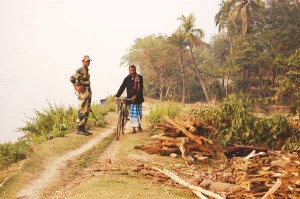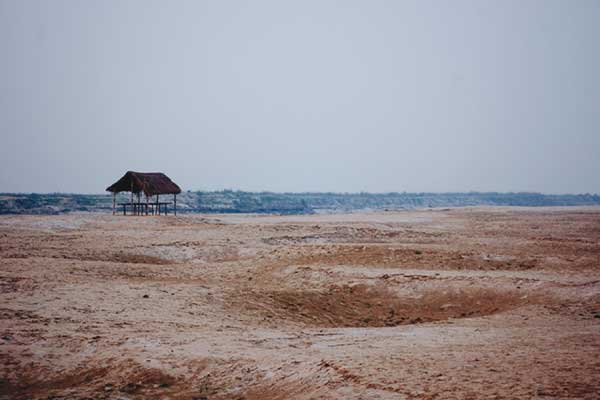As we walk around Haripukur village I realized the truism that one can’t argue with geography, it simply is what it is. On the zero line I came across a Masjid, its rear wall in India, the rest of the structure in Bangladesh! Walking further I reached a narrow strip of land through the middle of a pond. I found out that the locals were aware of the border alignment.
As I walked on the narrow strip of land, voices behind me cautioned not to cross the half way mark because I could unintentionally step into Bangladesh and if anything happened they wouldn’t be able to help! An elderly Bangladeshi gentleman walked upto me at the halfway point to chat. He said for the border villagers, united by poverty and deprivation, nationality and sovereignty are alien concepts to them.
The Panchayat members confessed that Left parties and the state government help Bangladeshi migrants to get Indian citizenship documents. In return, the migrants vote for the CPI (M) in state and national elections.
He said the people from both sides cross over regularly, all the time. So, when New Delhi says that the border has been sealed, the reality is that you can break this seal by just walking across.
The Politics of Infiltration
Kanchakarpur is a border village a couple of hours away from Kolkata. Members of the village panchayat meet almost every day of the week, and one of their most prominent concerns are Bangladeshi infiltrators. “About six months back, an immigrant came to India with guns in a sack of sugar. Such small incidents happen, like a man was arrested by the police, an infiltrator, who was let off soon after once he had bribed the police. The infiltrators can even choose to swim across some of the water bodies which separate the two countries,” said Shishir Dutta, member of Kanchakarpur Panchayat.
The Panchayat members confessed that Left parties and the state government help Bangladeshi migrants to get Indian citizenship documents. In return, the migrants vote for the CPI (M) in state and national elections. “There are some people who have houses both in India and Bangladesh, who have managed to procure ration cards, etc., by paying bribes to the right people, and again there are Indians who haven’t got any of these, and are facing problems as they do not have the money to bribe the officials,” revealed Rashid Ali, member, Kanchakarpur Panchayat.
In Panpakuria, angry villagers displayed their APL cards, or Above Poverty Line ration cards given to them by the government. The villagers say they are desperately poor, and need BPL or Below Poverty Line cards, but they don’t get them. “Bangladeshi migrants or those associated with them get it easily. Because we are not with CPI (M) we don’t get it,” said Samsunara, a villager. “Cadres of Left parties are helping the migrants infiltrate and settle down by providing them with ration cards, BPL cards and monetary help. CPI (M) helps the immigrants,” said Ranjana Biswas, a community activist.
 Along the border districts of West Bengal the presence of Bangladeshi immigrants is unmistakable. Prof Sunanda Sanyal of Ganamukti Parishad, a civil society organization, said, “It was easier in earlier times, in 1971 for example, when you could tell people from Bangladesh and India apart. Now this is no longer the case as Bangladeshis easily mix with the people here after infiltrating through the porous border. Even if you check their dialect it is no longer possible to tell them apart.” “The sinister part was that a minister of the Left Front used to encourage them, and as he was in charge of food, he issued ration cards to them, which helped them get on the voter’s list,” said Debabrata Bandhopadhyay.
Along the border districts of West Bengal the presence of Bangladeshi immigrants is unmistakable. Prof Sunanda Sanyal of Ganamukti Parishad, a civil society organization, said, “It was easier in earlier times, in 1971 for example, when you could tell people from Bangladesh and India apart. Now this is no longer the case as Bangladeshis easily mix with the people here after infiltrating through the porous border. Even if you check their dialect it is no longer possible to tell them apart.” “The sinister part was that a minister of the Left Front used to encourage them, and as he was in charge of food, he issued ration cards to them, which helped them get on the voter’s list,” said Debabrata Bandhopadhyay.
Large numbers of Bangladeshi refugees came to India after partition. By 1948, over 12 lakh people had crossed over to West Bengal, Assam and Tripura. Sixty years after Independence that number has gone up to 20 million, according to the Home Ministry. “First type of migrants – those who come for money – are not a threat to national security. But there’s another category called Bihari migrants. This section of people are a real threat to national security, as people who fought against India and Bangladesh, and whom Pakistan refused to take in due to demographic reasons settled in India with an anti-Indian attitude which has persisted into the second or even third generation immigrants. They are a threat to our security,” explained Bandhopadhyay.
Over the last six decades the demographic profile of West Bengal’s border districts has changed dramatically.
Darjeeling: Hindus (240%) Muslim (1235%)
Maldah: Hindus (174%) Muslim (372 %)
Murshidabad: Hindus (175%) Muslim (294 %)
Nadia: Hindus (285%) Muslim (357 %)
Source: 2001 Census Report
From 1951 to 2001, there has been a rapid growth of Muslim enclaves along the entire stretch of the Bengal-Bangladesh border. This has happened despite the increase in BSF deployment along the border over the last three decades. As long as Bangladeshi migrants are seen as politically expedient, India’s eastern frontier will continue to remain one of its biggest national security threats. “The Bihari Muslim population in East Pakistan (Bangladesh) who supported Pakistan, fought alongside Pakistan, was interned at three concentration camps near Dhaka. There were more than a million interns, but that number has dwindled to about a lakh or so from 1971-2008.
Large numbers of Bangladeshi refugees came to India after partition. By 1948, over 12 lakh people had crossed over to West Bengal, Assam and Tripura. Sixty years after Independence that number has gone up to 20 million, according to the Home Ministry.
The one million should have increased to two million or so by now if one goes by the rate of population growth in the region. It is safe to conclude that almost everyone from these internment camps migrated to West Bengal. One route where Bengali was not spoken was Chicken’s Neck at North Dinajpur, where Bengali, Hindi as well as Urdu are spoken. And once they gain entry into India, the rest of India is also open to them. Another more sophisticated route was Jalandi-Karimpur region, the Nadia-Murshidabad border to South 24 Parganas, straight to Kolkata at Kidderpore where a large section of the population speak Urdu or Watgunj, Metiabruz area of Kolkata.
It was in this area where Wajid Ali Shah, the 10th and last nawab of the princely kingdom of Awadh (Oudh) in present day Uttar Pradesh in India, settled after his kingdom was peacefully annexed by the colonial British administration in 1856. So the Bihari Muslims of Bangladesh who have settled in the urdu speaking belt of Kolkata are a real threat to national security, as people who fought against India and Bangladesh, and whom Pakistan refused to take in due to demographic reasons settled in India with an anti-Indian attitude which has persisted into the second or even third generation immigrants. They are a threat to our security,” said Bandhopadhyay.
In Tripura the border pillars separating India and Bangladesh are mute spectators to the infiltration across the 850 kilometre long border in the state. Many illegal migrants make their way to Agartala, the capital of Tripura. “It’s true that lots of Bangladeshis come through the border but it’s not possible by looking at the person to tell he is just a worker or a terrorist,” said a villager in a border village. Infiltration is an almost routine affair along unfenced portions of the border. A fact acknowledged and accepted by local politicians like Sudip Roy Burman, a member of Tripura’s legislative assembly from Agartala: “There is no doubt that hundreds of Bangladeshis cross the border each and every day. One wonders how that happens resulting in hundreds of Bangladeshis name in the electoral role, in spite of the fact that their names do exist in Bangladesh’s electoral list also.”
In Tripura’s borderland new fences are being built. But many villages are still dangerously close to the boundary, their proximity open to exploitation by terror groups. In fact, hundreds of Bangladeshis cross over as daily wage workers and at the end of the day, they go back to their villages in Bangladesh. “They cross over from the border. They come after breakfast, ply their rickshaws, have lunch here and go back before nightfall and we locals starve,” said a rickshaw puller in Agartala. More than 10,000 families have been displaced to make way for the border fence, and another 5,000 families face eviction. Citizen’s groups are fighting for proper rehabilitation and compensation of the affected families.






Dear Sir,
Thanks for the article. However there seems to be a remarked lack of empiricism in your conceptualization of the issue of borderland and its nuances. The statist parlance that you echo in every breath of this long diatribe against the Bangladeshi leaves spaces of concerns about understanding migration across the border for various other purposes other than ‘smuggling and infiltration’.
As a researcher working in this field I find myself disagreeing with the inglorious picture you paint where the poor are criminalised and the rent seeking capitalist regimes in Indian locations remain unquestioned about their propinquity to employ such infiltrators or the poor Indian state that can spend more than Rs. 2.5 lakhs on defense expenditure but still pay a BSF constable a paltry sum of Rs. 4680 per month enticing him to indulge in corruption and turn a blind eye to the mobility of people.
Instead of your diatribe against Bangladeshis as a whole, it would have been a much better paper had you attempted a structural analysis of the issue at hand.
Regards.
what do u thnk about urself.????how can u say that u have dfteaeed indians???see..ur nation is depending on our nation for a satellite and many other needs and u don’t have anything. so be in ur limit and if u crossed it, then u will be going to face dark mornings ahead .we also dont want war, bt peace.so enrich ur knowledge not by attacking other nation’s sites. ..so try to enrich ur knowlege 4 ur country’s development,a msg frm indian brother .thank u .